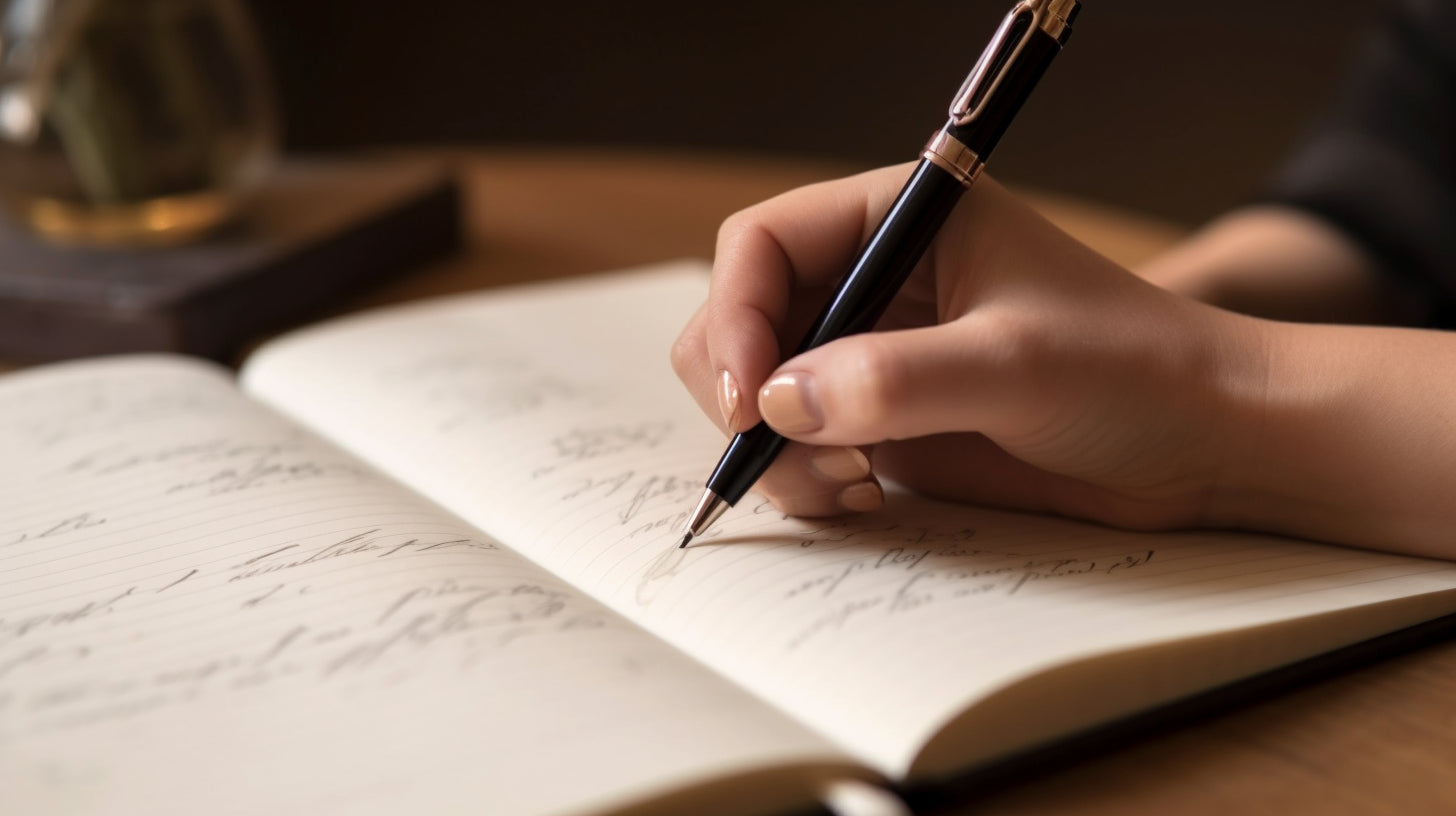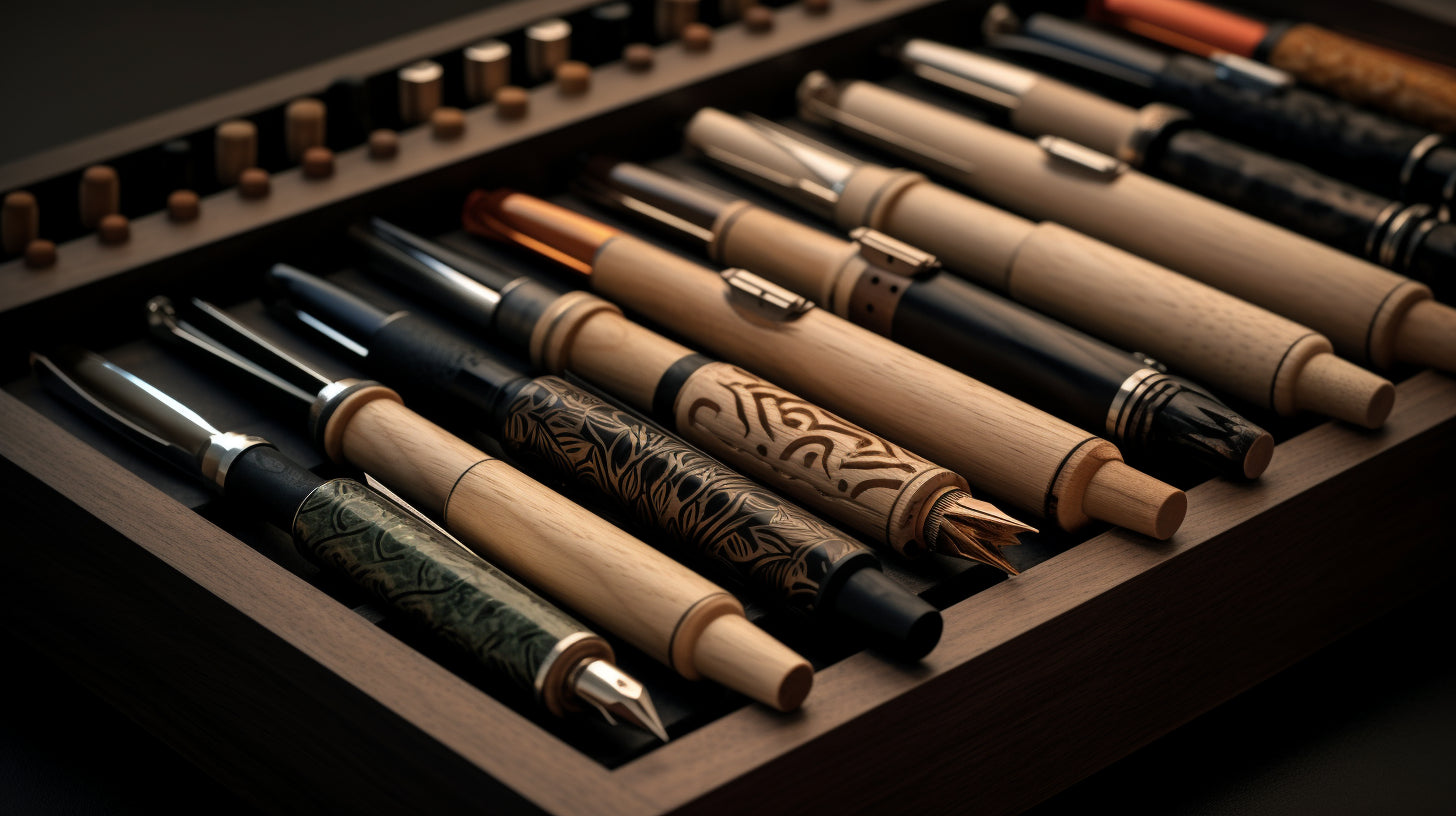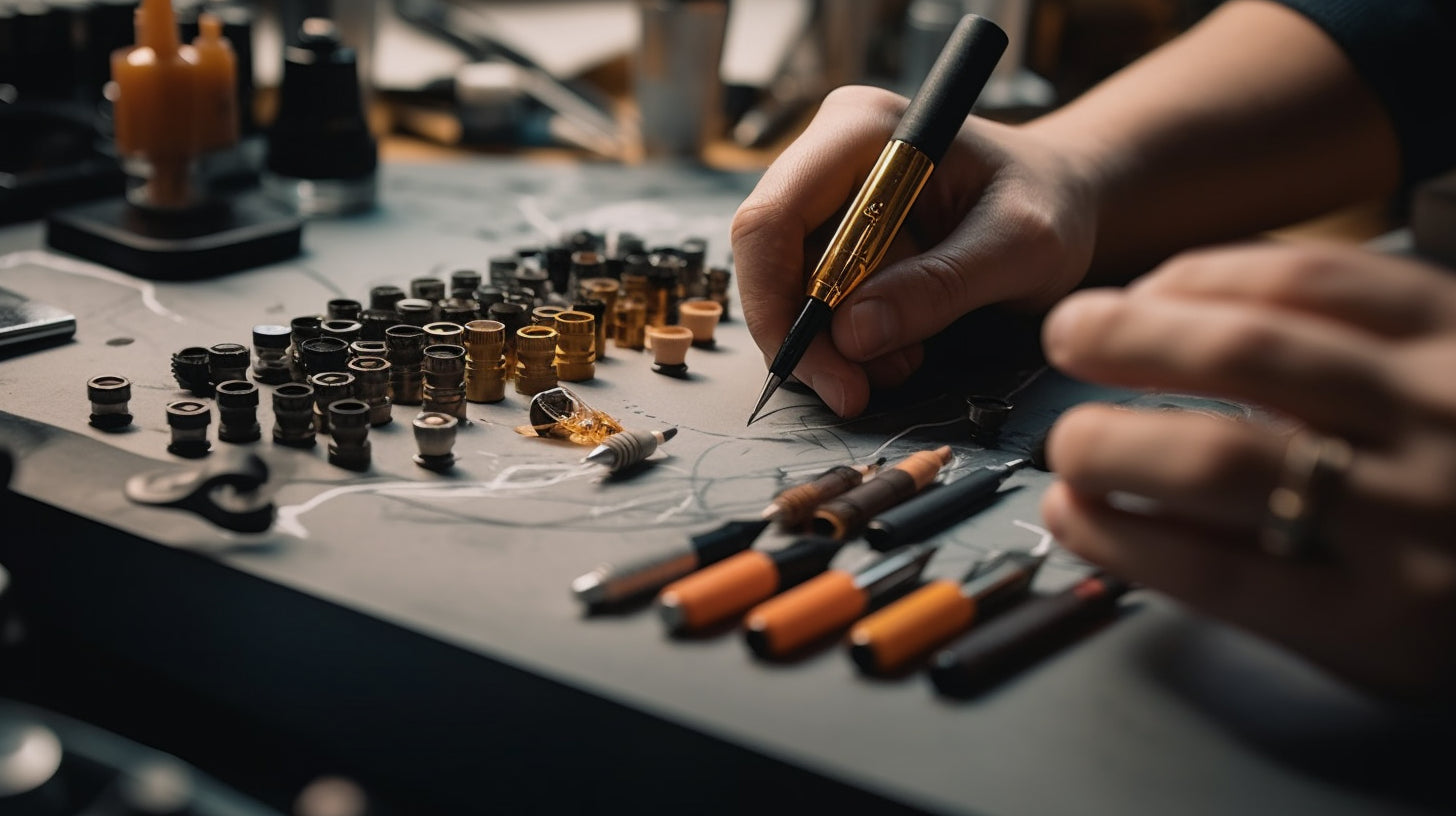
Fountain Pens 101: A Comprehensive Guide for Beginners
Fountain pens have been a symbol of sophistication and elegance for centuries. They offer a unique writing experience that is unmatched by other writing instruments, making them the perfect tool for those who value the art of handwriting. However, if you're new to the world of fountain pens, the various options available can be overwhelming.
This comprehensive guide will provide everything you need to know to get started with fountain pens, from selecting the right pen to learning advanced writing techniques. We'll cover the basics of fountain pens, including their construction, ink choices, nibs, and maintenance. Plus, we'll help you choose the right fountain pen for your needs and budget, provide tips on getting started with fountain pen writing, and learning advanced techniques like calligraphy and lettering.
In addition, we'll discuss collecting fountain pens, including information on vintage versus modern pens, collectibility and rarity factors, and building a fountain pen collection. Finally, we'll highlight the importance of joining the fountain pen community, a valuable resource for learning and connecting with like-minded individuals.
The Basics of Fountain Pens
Fountain pens provide an unparalleled writing experience, with smooth and free-flowing ink that can enhance creativity. This section covers the basics of fountain pens, including their definition, types of inks, nibs, and maintenance.
What is a Fountain Pen?
A fountain pen is a writing instrument that applies liquid ink onto paper using a nib. Unlike ballpoint or rollerball pens, fountain pens don't require pressure to release ink. The ink is drawn from a reservoir through the nib, providing a smooth and consistent flow onto paper.
Fountain pens are made of materials like plastic, metal, or resin, and come in various shapes and sizes.
Fountain Pen Inks
Fountain pen inks offer endless possibilities, from traditional blue and black inks to unique colors. They come in three main types:
- Dye-based inks: They are water-based and offer vibrant colors but tend to fade over time.
- Pigment-based inks: They are resistant to fading and light, making them ideal for archival work, but they tend to clog easily.
- Iron-gall inks: They produce long-lasting, waterproof, and fade-resistant ink, but require more maintenance.
Nibs and Tips
Nibs are critical to fountain pens as they dictate the smoothness and line variation of writing. Nibs come in materials like steel, gold, or titanium and determine the flexibility of the pen.
Fountain pen nibs come in different types like a fine, medium, or broad nibs, and a variety of tip sizes. A broader nib produces a thicker line, whereas a fine nib produces a thin line.
Maintenance and Care
Fountain pens require more care and maintenance than ballpoint pens or rollerballs. Proper cleaning and storage ensure a long-lasting and smooth writing experience.
When not in use, fountain pens should be stored upright to prevent the ink from drying up in the nib. Regularly cleaning the pen through flushing with water or pen cleaner is also essential.
In conclusion, fountain pens offer an enjoyable, personalized writing experience. Keeping the pen clean and well-maintained ensures it lasts longer.
Choosing the Right Fountain Pen
When it comes to choosing the perfect fountain pen, there are many factors to consider. Whether you are a beginner or a seasoned writer looking to upgrade your pen, choosing the right one can be overwhelming.
Budget Considerations
Setting a budget before you start shopping is important. Fountain pens range in price from as little as $5 to over $5,000, depending on the brand, materials, and craftsmanship.
Nib Material and Size
The nib is the most important part of the fountain pen, and it’s essential to choose the right material and size. Nibs are typically made of gold, stainless steel, or titanium, and come in a range of sizes from extra-fine to broad.
Grip and Weight
The grip and weight of the fountain pen are also important factors to consider. You want a pen that’s comfortable to hold and doesn’t strain your hand after extended writing sessions.
Brands and Reputation
There are many reputable fountain pen brands to choose from, like Montblanc, Pilot, Lamy, and Parker. It’s important to do your research and read reviews to get an idea of which brands and models are best suited to your needs.
Once you’ve considered these factors, start shopping. You can browse online retailers or visit a local pen store to see the pens in person. Try out a few options before making a decision.
Remember, the perfect fountain pen is out there waiting for you. With the right research and consideration, you’ll find it.
Getting Started with Fountain Pen Writing
Fountain pens are different from regular ballpoint pens, but once you get the hang of it, writing with a fountain pen can be a unique and enjoyable experience. Here are some tips to get you started:
Holding and Positioning the Pen
- Hold the pen loosely for smooth nib movement
- Avoid gripping the pen too tightly
- Hold the pen perpendicular or at a slight angle to the paper for comfortable writing experience
Ink and Paper Pairings
- Use high-quality paper specifically designed for fountain pens
- Avoid using regular printer paper as it can cause ink to bleed
- Try different ink and paper combinations to see what works best for you
Writing Techniques for Beginners
- Use a light hand and let the pen do the work
- Practice your strokes to get a feel for the pen's pressure
- Fountain pens work best with cursive handwriting
- Experiment with different writing styles to find what works best for you
Getting started with fountain pen writing may seem intimidating at first, but with practice, patience, and experimentation, you can master this art form. Remember to hold the pen lightly, use high-quality paper, and practice your handwriting techniques for the best results.
Advanced Writing Techniques with Fountain Pens
Fountain pens are widely popular because of their ability to write smoothly and consistently, which has made them ideal for writing beautifully. Advanced writing techniques allow individuals to explore different methods of enhancing their art while using fountain pens.
Calligraphy and Lettering
Calligraphy, an advanced writing technique, has a rich history. Using a fountain pen, you can design graceful and complex lettering to improve your writing's appearance and style. Calligraphy is versatile, allowing you to use different nib sizes and shapes to create unique lettering styles like Gothic, Italic, and Copperplate.
Ink Blotting and Splattering
Ink blotting and splattering are advanced writing techniques that require plenty of practice and skill. When utilized, these techniques can create texture and depth in your writing, resulting in a distinct aesthetic. Ink blotting is achieved by allowing ink to pool and create a blob for artistic effect, while splattering is achieved by flicking ink onto the paper to create a speckled or stippled effect.
Advanced Nib Manipulation Techniques
An advanced fountain pen technique is nib manipulation. This technique involves manipulating the nib to create different line widths and styles, which requires a delicate touch and lots of trial and error. Applying varying degrees of pressure on the nib as you write or using the side of the nib to create a thin stroke can change the line width. You can also experiment with nib angles to achieve a particular outcome.
It is essential to continue gradually and practice these advanced techniques. You can start with basic lettering techniques using fountain pens, and as you progress, you can gradually add more complexity. This way, you can develop your skills and avoid getting frustrated. It is crucial to start with cheap paper and ink until you hone your skills before using expensive materials.
In conclusion, if you are willing to put in the effort and practice, advanced writing techniques can add another dimension to your writing. Experimenting with fountain pen techniques can lead to a newfound appreciation for the art of writing.
Collecting Fountain Pens
Fountain pens are not only writing tools but also a work of art, and collecting them can be an exciting experience for pen enthusiasts. In this section, we will guide you on how to collect fountain pens and everything you need to know about it.
Vintage vs. Modern Fountain Pens
Collectors have two options when it comes to collecting fountain pens: vintage or modern. Both have their pros and cons, and it depends on personal preference.
Vintage Fountain Pens refer to pens that are at least 20 years old. These pens may have unique features or designs that are rare and not produced today. However, finding replacement parts and getting them repaired can be challenging, and they require more maintenance than modern pens.
Modern Fountain Pens, on the other hand, are easier to find and less expensive. They often have sleek, elegant designs, and replacement parts are readily available. However, modern pens can lack the character and charm of vintage pens.
Collectibility and Rarity Factors
Collectors look for unique or rare pens while building their fountain pen collection. Factors such as limited edition pens, special materials, or pens owned by famous individuals make pens more collectible and rare.
Pen manufacturers such as Montblanc or Pelikan have annual limited edition releases that are highly sought after by collectors. These pens can be sold out within hours of their release and can become valuable collectibles over time.
Building a Fountain Pen Collection
When starting a fountain pen collection, it's essential to set a budget since fountain pen prices vary from a few dollars for basic pens to thousands of dollars for rare or highly sought after pens. Collectors can slowly grow their collection over time, and there's no need to rush to acquire them all at once.
You can find pens online, in brick-and-mortar stores, or attend pen shows or auctions to find unique and rare pens. Before purchasing, it's crucial to research the pens you're interested in and their value to ensure you don't overpay or get scammed.
Conclusion
Collecting fountain pens can be a rewarding and fun hobby. Whether you choose to collect vintage or modern pens, it's essential to set a budget and do thorough research before purchasing. Fountain pens are works of art that bring joy and beauty to our daily lives, not just writing tools.
Troubleshooting Common Fountain Pen Issues
Fountain pens are a joy to write with, but they do come with a set of issues that can arise over time. In this section, we will discuss the most common problems that you might face while using a fountain pen and how to address them.
Dry or Hard-starting Nibs
One of the most common problems with fountain pens is the nib drying out or not starting properly. Here are some tips to troubleshoot dry or hard-starting nibs:
- Prime the Nib: gently squeeze the converter or cartridge to get the ink flowing.
- Clean the Nib: dip the nib in a cup of warm water and then wipe it clean with a soft cloth.
- Adjust the Nib: gently press it down or up until it aligns properly.
Leaks and Burping
Fountain pens are designed to hold a small amount of ink in the feed, but sometimes ink can leak or burp out of the pen. Here's how to troubleshoot leaks and burping:
- Check the Ink Level: Try emptying out some of the ink and see if the issue persists.
- Check the Feed: Check to make sure the feed is properly aligned and free of any debris.
- Store the Pen Upright: Store your pen upright when not in use to prevent this issue.
Ink Stains and Pen Maintenance
Ink stains on your fingers or clothes, and pen maintenance are common concerns while using fountain pens. Here are some tips to troubleshoot ink stains and ensure the longevity of your fountain pen:
- Clean Your Pen Regularly: Wipe the nib clean with a soft cloth after every use and gently rinse the nib and feed under warm water every few weeks.
- Choose Ink Colors: If you do get ink on your hands or clothes, wash it off immediately to prevent the stain from setting in.
- Use a Protective Sleeve: To prevent scratches and other damages to your pen, use a protective sleeve when carrying it around.
In conclusion, knowing how to address common fountain pen issues allows you to enjoy using your pen without any hindrances. With proper care and maintenance, your fountain pen can last for many years to come.
Joining the Fountain Pen Community
Joining the fountain pen community can be a rewarding and enriching experience for beginners, enthusiasts, or collectors. There are various ways to get involved, such as:
Online Communities and Forums
Joining online communities and forums dedicated to fountain pens on social media platforms like Facebook, Instagram, and Reddit is an accessible way to connect with other enthusiasts. These forums offer a great way to learn new techniques, seek advice on different brands, inks, papers, and share collections. You can discuss the latest trends in the fountain pen world, ask for opinions, and get advice.
Attending Fountain Pen Shows and Events
Attending a fountain pen show or event can provide an excellent opportunity to engage with the fountain pen community worldwide. Such events are usually held annually in different parts of the world and are attended by enthusiasts, collectors, and industry professionals. Apart from seeing the latest models, you can also try new fountain pens, attend workshops, panel discussions, and lectures on various fountain pen topics. Attending these events can be a fun and educational experience, even if you're just starting.
Making Connections with Pen Enthusiasts
Another way to join the fountain pen community is by connecting with pen enthusiasts through social media platforms, forums, or local pen clubs. You can organize a penpal exchange program, find local clubs or meetups in your area, and share collections, talk about fountain pens, and organize events. Making new friends who share the same passion for fountain pens can be an enriching experience, open doors to new opportunities and knowledge.
In conclusion, joining the fountain pen community can enhance your experience and help you connect with other enthusiasts worldwide. You can share your passion, learn new techniques, seek advice, and forge lifelong connections.
Conclusion
Fountain Pens are not just ordinary pens, they hold a deep tradition, allure and excitement for the pen enthusiasts. Getting started with a Fountain Pen requires a basic understanding of its mechanism, selecting the suitable tool for your needs and beginning with writing. As you grow more confident, you can experiment with different techniques and even start your collection of Fountain Pens and join the enthusiastic community of collectors.
However, just like any other hobby, a Fountain Pen also has its fair share of challenges and issues. With the right techniques, you can overcome these issues and have a smooth writing experience.
Joining the Fountain Pen community or pen shows can be an excellent opportunity to meet like-minded individuals and explore the art of Fountain Pen writing. With the help of online communities and forums, you can exchange knowledge, ideas, and techniques with other pen enthusiasts.
Overall, a Fountain Pen can offer a supreme writing experience with its unique design and rich history. It is a worthwhile investment for anyone looking to elevate their writing experience to a new level. Fountain Pens continue to captivate writers and collectors worldwide, and its charm is here to stay.
Frequently Asked Questions
-
What is a fountain pen?
A fountain pen is a writing instrument that uses a nib and an ink reservoir to produce ink flow onto paper. The ink flow is controlled by the user's hand pressure and the angle of the nib on the page.
-
What are the benefits of using a fountain pen?
Some benefits of using a fountain pen include improved writing comfort and control, more personalized writing style, higher-quality ink that dries faster, reduced hand fatigue and improved penmanship, and eco-friendliness by reducing plastic waste.
-
How do I refill a fountain pen?
To refill a fountain pen, remove the barrel from the nib section, unscrew the converter or cartridge, and refill the ink. To avoid ink spills or leakage, be sure to hold the pen steady and gently tap the ink bottle to eliminate air bubbles in the converter or cartridge.
-
What types of nibs are available for fountain pens?
Fountain pens come in different nib sizes and materials. Common nib materials include gold, silver, and stainless steel. The nib size can vary from extra fine to broad and can alter the thickness and style of writing.
-
What is the difference between a cartridge and a converter for fountain pens?
A cartridge is a pre-filled container of ink that many fountain pens use for ease of use and cleanliness. A converter is a refillable reservoir that can be filled with bottled fountain pen ink. The converter allows the user to experiment with different ink colors and types at their leisure.







Leave a comment
This site is protected by hCaptcha and the hCaptcha Privacy Policy and Terms of Service apply.